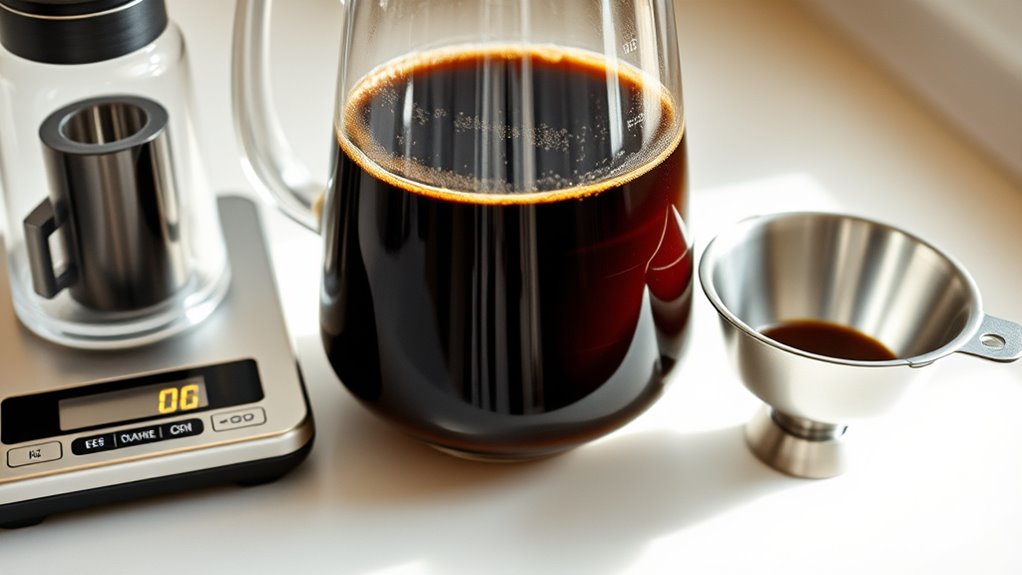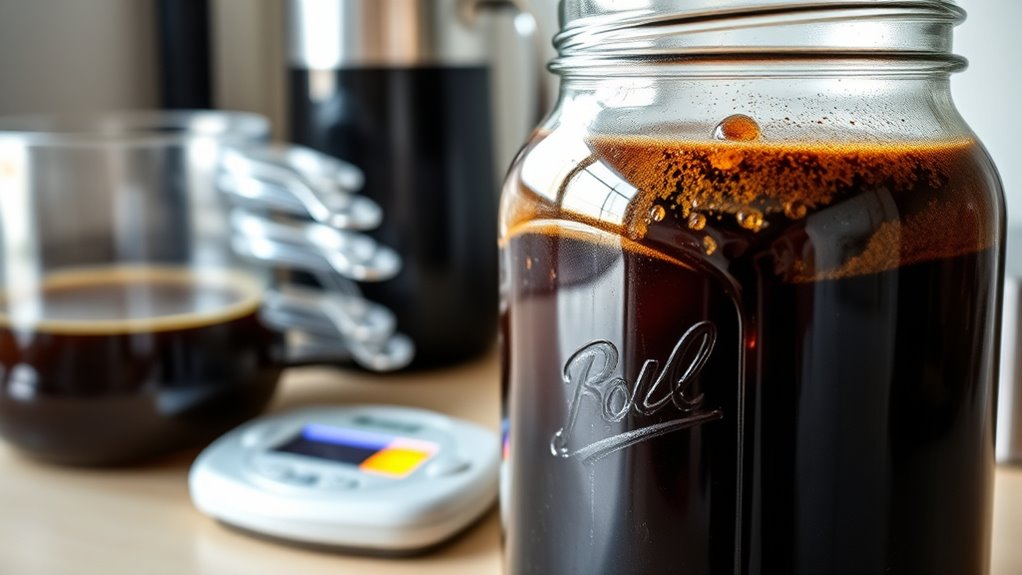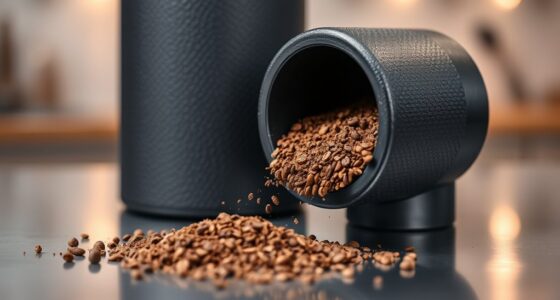To scale cold brew safely at home, start by precisely adjusting your water-to-coffee ratio, typically 4:1 or 5:1, depending on your preferred strength, and use a scale for accuracy. Choose airtight, non-reactive containers like glass jars and keep them refrigerated at or below 40°F to preserve freshness, which lasts up to two weeks. Maintain cleanliness of all equipment and regularly check your storage for signs of spoilage. Keep these key steps in mind as you expand your batch size.
Key Takeaways
- Use precise water-to-coffee ratios (4:1 or 5:1) and measure accurately when scaling up recipes.
- Select airtight, non-reactive containers like glass jars for safe storage of larger batches.
- Maintain refrigeration at or below 40°F (4°C) and consume within two weeks for quality and safety.
- Sanitize all equipment thoroughly before brewing and handle the cold brew carefully to prevent contamination.
- Label each batch with brewing date and perform regular smell or taste checks before consumption.

Scaling up your cold brew at home can be a rewarding process, but it’s essential to guarantee safety to prevent spoilage and ensure quality. When making larger batches, paying close attention to the water to coffee ratio is crucial. Typically, a standard ratio is 4:1 or 5:1 water to coffee, but when scaling up, you need to adjust this proportion carefully. Too much coffee can result in a brew that’s overly concentrated and difficult to store without risking spoilage, while too little may produce a weak, underwhelming flavor. Measure your coffee and water precisely, and consider using a scale for accuracy. This helps guarantee consistency across batches and reduces the chance of waste or unsafe brewing practices.
Choosing the right storage container options is equally important for maintaining the freshness and safety of your cold brew. You want containers that are airtight, non-reactive, and easy to clean. Glass jars with tight-fitting lids are a popular choice because they don’t absorb odors and prevent contamination. If you prefer plastic, opt for BPA-free, food-grade containers that are sturdy and have secure seals. Avoid using containers that are porous or prone to leaks, as these can introduce bacteria or mold. When storing your cold brew, keep it refrigerated at or below 40°F (4°C), as bacteria can grow rapidly at warmer temperatures. Proper storage isn’t just about the container; it’s also about how long you keep the brew. Generally, cold brew can last up to two weeks in the refrigerator if stored properly. Always label your containers with the date brewed so you can keep track and avoid drinking stale or spoiled coffee.
Handling larger quantities also means paying attention to cleanliness throughout the process. Wash your containers thoroughly before use, and sanitize your brewing equipment to minimize the risk of contamination. When preparing your batch, ensure that water quality is high—filtered or spring water is best—since impurities can affect flavor and safety. Once brewed, strain your cold brew carefully to remove grounds and ensure clarity, which also helps prevent bacterial growth. Throughout storage, avoid opening the container unnecessarily, as introducing air can promote spoilage. When you’re ready to enjoy your batch, do so within the recommended timeframe, and always give it a sniff or taste test to check for any off-odors or flavors, which indicate spoilage.
Frequently Asked Questions
Can I Use Different Coffee Bean Types for Batch Scaling?
Yes, you can use different coffee bean varieties for batch scaling, but keep in mind it may impact flavor consistency. Mixing beans can create unique flavors, but if you want a consistent taste, stick to one variety or blend similar beans. Experiment carefully, and always record your ratios. This way, you maintain control over flavor profiles and ensure your cold brew remains enjoyable every time you make a larger batch.
How Does Ambient Temperature Affect Cold Brew Safety?
Ever wondered how ambient temperature impacts your cold brew safety? Higher temperatures can accelerate microbial growth, making temperature control essential. If your environment gets warm, bacteria can multiply quickly, risking spoilage. To keep your batch safe, store your cold brew in a cool, dark place or refrigerate promptly. Maintaining proper temperature control helps prevent harmful microbial growth, ensuring your cold brew stays fresh and safe to enjoy longer.
What Are the Signs of Spoilage in Large Batches?
You should look for fermentation signs like a sour smell or fizzy bubbles, which indicate spoilage. Mold detection is vital—spot any fuzzy or discolored patches on the surface or container. If your large batch develops an off-putting odor, slimy texture, or visible mold, it’s best to discard it. Always trust your senses; if something seems off, avoid consuming to stay safe.
Is It Safe to Reuse Cold Brew Concentrate?
Reusing cold brew concentrate can be safe if you practice proper home sterilization and focus on concentrate preservation. Make sure to store it in a clean, airtight container and refrigerate promptly after each use. Check for signs of spoilage, like sour smell or mold, before reusing. Reusing concentrate is okay if you maintain cleanliness and consume it within a week, but always prioritize safety to avoid any health risks.
How Long Can I Store Scaled Batches Safely?
You can store scaled cold brew batches safely for up to two weeks in the refrigerator. Keep an eye out for spoilage indicators like off-odor, change in color, or mold. To guarantee freshness, use airtight containers and always smell and taste a small amount before drinking. Proper storage helps prevent spoilage and maintains quality, so plan your batches accordingly to enjoy fresh, safe cold brew throughout the week.
Conclusion
Now that you’ve mastered scaling your cold brew safely at home, it’s funny how a simple tweak can turn your daily routine into a gourmet experience. Just last week, I accidentally made a larger batch and found it lasted longer than I expected—coincidence or not, you’ll enjoy the extra brew without any worries. Keep experimenting and enjoy your perfectly scaled cold brew, confident that you’re doing it safely every time. Cheers to brewing smarter!









